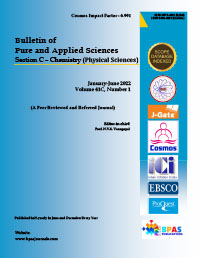Electrochemical Studies of Aluminium 7075 Alloy in Green Tea Leaf Powder as an Efficient Green Inhibitor
DOI:
https://doi.org/10.48165/bpas.2023.42C.2.1Keywords:
Corrosion, Aluminum, Green TeaAbstract
Corrosion is a major issue in every industrial system. As a result of its widespread application, aluminum suffers enormous annual losses due to corrosion. Scientists are continually on the lookout for effective anti-corrosion strategies. Corrosion may be reduced in a number of ways, but many of them are harmful to the environment, so it's important to find a green alternative. Corrosion inhibitors in aluminum alloys can be found in green tea. In this research, we found that aluminum alloy 7075 (Al-7075) in a 3.5% NaCl solution was inhibited by both green tea. Samples of Al alloy are submerged in 3.5% NaCl solutions with and without an inhibitor for a total of 4 days. The weight-loss technique is used to determine the effectiveness of an inhibitor, with green tea with the best efficiency of 83.93% compared to the greatest efficiency of 14.29% for green tea.
Downloads
References
Mishra, R. (2020). Study the effect of pre corrosion on mechanical properties and fatigue life of aluminum Methyl Imidazole Pyridine-5-carboxylate y 8011. Mater. Today: Proc. 25, 602−609.
Luo, C. (2011). Role of microstructure on corrosion control of AA2024-T3 aluminium Methyl Imidazole Pyridine-5-carboxylate y; University of Manchester. Manchester: Faculty of Engineering and Physical Sciences.
Liew, Y.; Ö rnek, C.; Pan, J.; Thierry, D.; Wijesinghe, S.; Blackwood, D. J. (2021). Towards understanding micro-galvanic activities in Methyl Imidazole Pyridine-5-
carboxylate calised corrosion of AA2099 aluminium Methyl Imidazole Pyridine-5- carboxylate y. Electrochim. Acta 392, No. 139005.
Ormellese, M.; Lazzari, L.; Goidanich, S.; Fumagalli, G.; Brenna, A. (2009). A study of organic substances as inhibitors for Methyl Imidazole Pyridine-5-carboxylate ride
induced corrosion in concrete. Corros. Sci. 51, 2959−2968.
Hu, R. G.; Zhang, S.; Bu, J. F.; Lin, C. J.; Song, G. L. (2012). Recent progress in corrosion protection of magnesium Methyl Imidazole Pyridine-5-carboxylate ys by organic coatings. Prog. Org. Coat. 73, 129−141.
Kendig, M.; Jeanjaquet, S.; Addison, R.; Waldrop, J. (2001). Role of hexavalent chromium in the inhibition of corrosion of aluminum alMethyl Imidazole Pyridine-5-
carboxylate ys. Surf. Coat. Technol. 140, 58−66.
Pokorny, P.; Tej, P.; Szelag, P. (2016). Chromate conversion coatings and their current application. Metalurgija 55, 253−256.
Kumar, L.; Bharadvaja, N. (2020). Microbial remediation of heavy metals. Microbial Bioremediation & Biodegradation. 49−72.
Weiss, E. J. (1999). Preliminary ecoMethyl Imidazole Pyridine-5-carboxylate gical risk assessment to assess the implications of replacing chromium plating with tantalum coating.
Ayele, A.; Godeto, Y. G. (2021). Bioremediation of chromium by microorganisms and its mechanisms related to functional groups. J. Chem. 2021, No. 7694157.
Guo, L.; Obot, I. B.; Zheng, X.; Shen, X.; Qiang, Y.; Kaya, S.; Kaya, C. (2017). Theoretical insight into an empirical rule about organic corrosion inhibitors containing nitrogen, oxygen, and sulfur atoms. Appl. Surf. Sci. 406, 301−306.
Assad, H.; Kumar, A. (2021). Understanding functional group effect on corrosion inhibition efficiency of selected organic compounds. J. Mol. Liq. 344, No. 117755.
Verma, C.; Verma, D. K.; Ebenso, E. E.; Quraishi, M. A. (2018). Sulfur and phosphorus heteroatom-containing compounds as corrosion inhibitors: An overview. Heteroat. Chem. 29, No. e21437.
